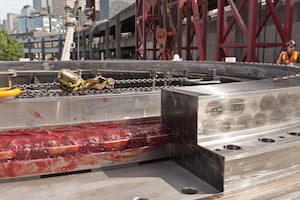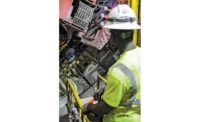The wait for one of the world's largest tunnel-boring machines to resume excavation under downtown Seattle should come to an end in late November, according to a new schedule released by contractor Seattle Tunnel Partners (STP).
Dubbed "Bertha," the TBM has sat idle since December 2013, when it overheated; then, it was shut down, so crews could search for a cause and a solution. Bertha stopped just 1,083 ft into a 9,270-ft (1.7-mile) course to create space for a new Highway 99, which will replace the aging and seismically vulnerable Alaskan Way Viaduct. With the 57.5-ft-dia machine’s cutterhead now under repair, the joint venture of New York-based Dragados USA, Spain-based ACS Group and California-based Tutor Perini Corp. believes it can have Bertha digging again in four months.
Crews started installing a new main bearing—the fix's main component—on the machine in mid-July.
With Bertha potentially churning earth again in late fall, STP plans to have the tunnel open to drivers in spring 2018, which is beyond the state's original target date of November 2016 and STP's original target date of December 2015. STP expects that, once Bertha relaunches her tunneling efforts, she will take approximately one year to go the remaining 8,000-plus ft, north to the project’s end point near Seattle’s Space Needle.
The project owner, the Washington State Dept. of Transportation, says it cannot verify the contractor’s schedule. “The contractor’s schedule has changed, but the contract that governs their work remains the same,” says Todd Trepanier, administrator of WSDOT’s Alaskan Way Viaduct Replacement Program. “The state is a paying customer in this transaction, and we’re intent on getting what we contracted for.”
STP has worked with machine manufacturer Hitachi Zosen, Japan, since the 326-ft-long TBM exhibited trouble. After an investigation, crews discovered damage to the seal system and the main bearing. The cause of that damage has yet to be determined. To access Bertha for repairs, STP did not disassemble the machine from the rear and reach the front cutterhead through the already tunneled portion of the project; instead, STP dug an access shaft in front of the machine and, in March, lifted the TBM's front end from the 120-ft-deep pit.
In addition to the main bearing, STP crews have installed portions of a new seal system, which includes the addition of reinforced steel, a new monitoring system and, to help prevent clogging, upgrades to the soil-conditioning system.
Inside the machine, bigger openings in the cutterhead, longer mixing arms to stir dirt, a heavier bearing, and steel rods and plates to reinforce the front end will give Bertha a new robustness.
Once STP decided on the access-pit repair method, officials had hoped to resume tunneling in August. “Fully disassembling and assessing the machine was always the key to determining how long the repairs would take,” says Chris Dixon, STP project manager. “We want to reassemble the machine and resume tunneling as quickly as possible, but we also want to ensure the repairs are done right.”
Neither side has announced a dollar estimate on the delay. Says Trepanier, “We will continue to protect taxpayers and hold the contractor responsible for their work as they deliver this vital project.”






Post a comment to this article
Report Abusive Comment